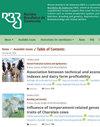与传统系统相比,综合作物-牲畜系统可持续性的经济价值
IF 1.2
4区 农林科学
Q3 Agricultural and Biological Sciences
Revista Brasileira De Zootecnia-Brazilian Journal of Animal Science
Pub Date : 2023-08-07
DOI:10.37496/rbz5220220052
引用次数: 0
摘要
-本研究的目的是评估与专门从事单一栽培的传统系统相比,提高作物-牲畜综合系统(ICLS)经济价值的潜力。试验区面积为16.02 ha,分为18个围场,每个围场面积0.89 ha,采用随机区组设计,设置3个重复,6个生产系统模型:作物系统[玉米(Zea mays)谷物生产]、牲畜系统(放牧条件下的肉牛)和4个ICLS,鉴定为:ICLS-1,玉米与Marandu palisadegrass [Urochloa brizantha (Hoechst.);A.里奇。韦伯斯特简历。马兰度(同属Brachiaria brizantha)同时播种,不使用除草剂;ICLS-2,玉米和马兰度栅栏草与除草剂同时播种;ICLS-3,玉米和马兰度栅栏草延迟播种;和ICLS-4,玉米和Marandu栅栏草同时播种,在玉米行和行之间施用除草剂。考虑到价格和生产率的不确定性,我们展示了经济影响分析与风险优化和基于蒙特卡罗模拟的贴现现金流技术相结合。与传统系统相比,ICLS系统的附加值和投资回报率指标具有经济优势。研究还发现,与传统系统相比,ICLS需要更小的操作面积才能达到经济收支平衡点。与专门从事单一栽培的传统系统相比,综合系统每公顷提供更低的财务和操作风险水平和更高的经济价值。本文章由计算机程序翻译,如有差异,请以英文原文为准。
The economic value of sustainability of the integrated crop-livestock system in relation to conventional systems
- The objective of this study was to evaluate the potential of improving the economic value of integrated crop-livestock systems (ICLS) compared to conventional systems specialized in monoculture. The experimental area was 16.02 ha, divided into 18 paddocks of 0.89 ha each, organized in a randomized block design, with three replicates and six models of production systems: crop system [corn ( Zea mays ) grain production], livestock system (beef cattle under grazing conditions), and four ICLS, identified as: ICLS-1, corn integrated with Marandu palisadegrass [ Urochloa brizantha (Hoechst. ex A. Rich.) R.D. Webster cv. Marandu (syn. Brachiaria brizantha cv. Marandu] sown simultaneously without herbicide; ICLS-2, corn and Marandu palisadegrass sown simultaneously with herbicide; ICLS-3, corn and Marandu palisadegrass with lagged sowing; and ICLS-4, corn and Marandu palisadegrass sown simultaneously, with herbicide in rows and between-rows of corn. We demonstrated the economic impact analysis combined with the risk optimization and discounted cash flow techniques based on Monte Carlo simulation, considering price and productivity uncertainties. The indicators of added value and return on investment of ICLS had an economic advantage compared with conventional systems. It was also found that ICLS needed a smaller operational area than conventional systems for the economic break-even point. Integrated systems provide lower financial and operational risk levels and greater economic value per hectare compared with conventional systems specialized in monoculture.
求助全文
通过发布文献求助,成功后即可免费获取论文全文。
去求助
来源期刊
CiteScore
1.90
自引率
0.00%
发文量
25
审稿时长
8 weeks
期刊介绍:
The Revista Brasileira de Zootecnia (RBZ; Brazilian Journal of Animal Science) encompasses all fields of Animal Science Research. The RBZ publishes original scientific articles in the areas of Aquaculture, Biometeorology and Animal Welfare, Forage Crops and Grasslands, Animal and Forage Plants Breeding and Genetics, Animal Reproduction, Ruminant and Non-Ruminant Nutrition, and Animal Production Systems and Agribusiness.

 求助内容:
求助内容: 应助结果提醒方式:
应助结果提醒方式:


